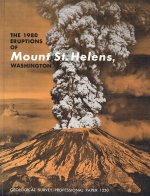|
|
|
|
|
|
|
|
|
|
|
|
|
 |
Volcanic Events, pg. 2 Mount St. Helens History, pg. 3-15 Eyewitnesses, pg. 53-67 Absolute Times, pg. 81-82, 86 Activity Sequence, pg. 127-134 Gas Studies, pg. 190-191 |
Chemical
Compositions, pg.
233-250
Ash Clouds, pg. 323-333 Blast Dynamics, pg. 379-400 Rapid Deposition, pg. 466-478 Phreatic Explosions, pg. 509-511 New Lava Dome, pg. 540-544 Ash-Fall Deposits, pg. 568-584 Water Chemistries, pg. 659-664 River Water Quality, pg. 719-731 |
THE 1980 ERUPTIONS OF
MOUNT ST. HELENS,
WASHINGTON
Edited by PETER W. LIPMAN and DONAL R. MULLINEAUX
Early results of studies of volcanic events in 1980, geophysical monitoring of activity, and studies of volcanic deposits, effects, and potential hazardsGEOLOGICAL SURVEY PROFESSIONAL PAPER 1250
UNITED STATES DEPARTMENT OF THE INTERIOR James G. Watt, Secretary
UNITED STATES GEOLOGICAL SURVEY Dallas L. Peck, Director
UNITED STATES GOVERNMENT PRINTING OFFICE Washington, D.C.: 1981
For sale by the Superintendent of Documents, U.S. Government Printing Office Washington, D.C. 20402
LIBRARY OF CONGRESS CATALOG NUMBER 81-600142
First printing 1981 Second printing 1982
Editors' notes:
Because of the preliminary nature of some of the work reported in this volume, two informal names for geographic features have been used and retained in several reports, as being the clearest way to refer to these features. The names are Coldwater Ridge, applied to an east-west ridge 9-10 km north to northwest of Mount St. Helens, and Harrys Ridge, used for a 1.6-km-long ridge trending north-south, immediately west of Spirit Lake.
Any use of trade names is for descriptive purposes only and does not
imply endorsement by the U.S. Geological Survey.
FOREWORD
The reawakening of Mount St. Helens volcano in March 1980, and its catastrophic eruption of May 18, surely will rank among the most significant geologic events in the United States in the 20th century. The debris avalanche, explosive eruption, and associated mudflows and floods resulted in the loss of about 60 lives--including our own David Johnston--and property damage and destruction totaling billions of dollars. We in the U.S. Geological Survey are proud of the role we played in helping to minimize these losses.
By its Organic Act of 1879, the Geological Survey was charged with "classification of the public lands, and examination of the geological structure, mineral resources, and products of the national domain* * *." Under that charge, volcanoes and volcanic processes-- ancient and contemporary--have been studied to advance the knowledge of the geology in our country. Within the last several decades, attention has been directed increasingly toward assessment of the risks to life and property posed by geologic hazards, including volcanic eruptions, earthquakes, and ground failures. The passage of the Disaster Relief Act of 1974 (P.L.93-288) led to the responsibility of the Geological Survey "to provide technical assistance to State and local governments to ensure that timely and effective disaster warning is provided" for all geologic hazards.
Earth scientists can contribute to the reduction of geologic hazards through improvement in the basic understanding of the phenomena involved--by (1) describing the nature and geographic distribution of possible effects and (2) developing a capability to predict hazardous events. Fortunately, Dwight Crandell, Donal Mullineaux, and their colleagues had spent nearly 20 years studying the eruptive histories and associated volcanic hazards of the Cascade volcanoes. From their research, they concluded that Mount St. Helens was the youngest and most active of the Cascade volcanoes. Indeed as early as 1975, in a paper published in Science, which was later expanded with additional information into U.S. Geological Survey Bulletin 1381-C published in 1978, Crandell, Mullineaux, and colleagues predicted that Mount St. Helens, the most active and most explosive Cascade volcano, would erupt again, "perhaps before the end of this century." This prediction, of course, has come true. Equally important, the descriptions and locations of the potential hazards associated with an eruption proved accurate, with few exceptions.
The volcanic hazards assessment by Crandell and Mullineaux provided a key element in reducing hazards to life and property. Another key element was the development--in cooperation with the University of Washington--of a seismograph network and the capability for analysis of local earthquake activity. A week of premonitory earthquake activity under Mount St. Helens sounded the earliest warning of the eruptive sequence that began on March 27.
How will Mount St. Helens behave in the coming months or years? Which other Cascade volcano might erupt next? When will it occur and what might be the effects? These are questions that earth scientists cannot yet answer with precision, but current studies on Mount St. Helens and other Cascade volcanoes may provide clues to the answers. In 1981, the U.S. Geological Survey established a facility in Vancouver, Washington, to serve as a field headquarters for monitoring and investigations of Mount St. Helens as well as other Cascade volcanoes.
Science advances by careful documentation and interpretation of observations, formulation of hypotheses, and the testing of interpretations and hypotheses by new observations and experiment. The reports in this volume represent a vital part of the scientific process. Earth scientists--and we in the Geological Survey in particular--have a responsibility to document and understand the current eruptive activity at Mount St. Helens in as much detail as possible. We are embarking on an exciting epoch in volcanology, during which we can anticipate major advances in deciphering the early warning signals of stirring dormant volcanoes and in understanding the fundamental mechanisms of volcanism. This tremendous scientific opportunity and challenge must be matched with commensurate, increased obligation to apply the research results for the mitigation of volcanic hazards and related ecologic and socio-economic impacts.
The lessons of Mount St. Helens must not--and will not--be forgotten.
Dallas L. Peck, Director, U.S. Geological Survey
| START & IMAGES |
|